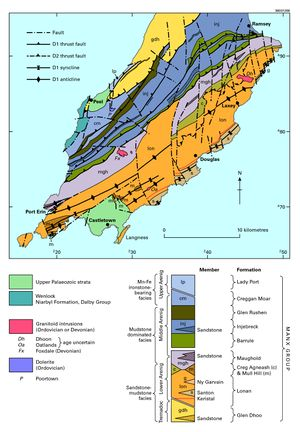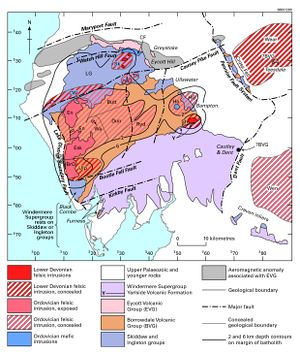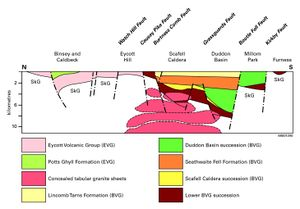Timing and structural setting of Caradoc magmatism, Ordovician, Northern England
| From: Stone, P, Millward, D, Young, B, Merritt, J W, Clarke, S M, McCormac, M and Lawrence, D J D. 2010. British regional geology: Northern England. Fifth edition. Keyworth, Nottingham: British Geological Survey. |
Age and duration of the volcanism




In the central Lake District, the age and time span of the volcanic groups are constrained biostratigraphically by the unconformities with the underlying and overlying sedimentary strata. The volcanic rocks lie within an interval of up to 15 Ma, above the lower Llanvirn, uppermost parts of the Skiddaw Group but below the Caradoc to Ashgill (Cautleyan) base of the Dent Group. At Cross Fell and in the northern Lake District, mid and late Caradoc shelly faunas have been found in the marine strata overlying the volcanic rocks whereas, in the southern Lake District, the basal beds of the Dent Group are of mid Ashgill age. No macrofossils have been found in the volcanic rocks but an acritarch assemblage, obtained from grey mudstone of the Holehouse Gill Formation in the Ulpha valley (SD 182 927), was previously thought to indicate a Caradoc age. However, the ranges of the taxa critical to this interpretation have been extended recently and it is now thought that all of the acritarchs obtained from these rocks were derived from erosion of the Skiddaw Group. The palynological assemblage from the Overwater Formation at the base of the Eycott Volcanic Group suggests a biostratigraphical age not older than Llanvirn but possibly Caradoc.
Precise U-Pb ages determined for zircons from the lower and middle parts of the Borrow-dale volcanic succession are Caradoc (451.6 ± 1.4 and 452.8 ± 0.7 Ma). Palaeomagnetic data from both the Eycott and Borrowdale Volcanic groups have been interpreted to indicate emplacement during the single period of normal magnetic polarity that lasted for about 5 Ma during Caradoc times. Thus, volcanism is now thought to have been restricted to the Caradoc.
Structural controls on the magmatism
The present distribution of the Caradoc igneous rocks, and the margins of the Lower Palaeozoic Lake District Block, probably reflects the positions of the original graben boundary faults (P916043). Though now largely identified from Carboniferous displacements, the Maryport Fault system probably approximates to the northern margin of the Eycott Volcanic Group and, unless there is a very substantial strike-slip displacement on it, the Causey Pike Fault represents the boundary between the Eycott and Borrowdale volcanic fields. The position of the southern margin of the latter is inferred from the dramatic stratigraphical thinning that occurs, from about 6 km in the Duddon valley, to discontinuous remnants in the Furness inliers (P916044). Geophysical evidence for relatively shallow magnetic basement beneath the Windermere Supergroup supports an east–west oriented margin to the half-graben.
The presence of large volumes of low density silicic volcanic and granitic rocks at depth much beyond the Cumbria coast seems unlikely in the light of recent geophysical interpretations, though a separate magmatic centre may be represented by granitic plutons beneath the Isle of Man. Eastward from the Lake District, Borrowdale and Eycott volcanic rocks are present in the Cross Fell Inlier, and farther east, on the Alston Block, pyroclastic rocks in the Teesdale Inlier are assigned to the Borrowdale Volcanic Group. Elsewhere on the Alston Block, the few boreholes through the Carboniferous overburden penetrated only the Skiddaw Group and Devonian Weardale Granite. Either the Ordovician volcanic rocks deposited in the Alston Block area were subsequently eroded, or a significant Caradoc volcanic depocentre did not develop in this area.
Faults with known or inferred Ordovician displacement mainly have the following trends: north to north-north-east, east to east-north-east, and north-west (P916045). The north-westtrending set are principally volcanotectonic, that is, they are associated directly with magma movement, and are concentrated in the Scafell and Haweswater areas. In the northern Lake District, major fractures in the Avalonian basement, with east to east-north-east trend, were reactivated as extensional faults. From north to south, the principal structures involved are now represented by the Watch Hill, Causey Pike, Burtness Comb and Grassguards faults, and by two similar structures inferred to delimit the southern extent of the Borrowdale Volcanic Group. Within the Borrowdale Volcanic Group, some faults of this trend developed progressively during formation of the Scafell Caldera; they include a set of synthetic and antithetic faults in Langdale, which together form a keystone graben.
Most of the north–south faults (P916043) and (P916044) are major structures with a complex movement history and are possibly reactivated, basement fracture zones. Three extensive north–south structures divide the Borrowdale volcanic outcrop into blocks. The Lake District Boundary Fault Zone marks the western margin of the Lower Palaeozoic inlier and coincides with the western margin of the batholith; a single fault in its southern extent, it passes northwards into a network of fault strands. One of the components, the arcuate Thistleton Fault, controlled accumulation of the volcanic rocks and so may also have influenced emplacement of Ordovician components of the subvolcanic batholith. Farther east, the Coniston Fault appears to be a simple structure. By contrast, the Troutbeck Fault System is a 4 km-wide network of anastomosing fault strands, making it the most impressive structure within the inlier. To the west of this structure, the volcanic strata are inclined eastwards, whereas those to the east are inclined westwards, bringing Skiddaw Group to the surface in the Bampton Inlier (P916043). Furthermore, the Troutbeck faults follow the deep structural col, established from geophysical data, that separates the western and eastern parts of the batholith. Other structures in this set that were significant in the volcanotectonic development of the Borrowdale Volcanic Group are the Greendale, Dorehead and Whillan Beck faults (P916044).
Pre-volcanic uplift
In late Llanvirn to earliest Caradoc times, the Lake District was elevated prior to the onset of volcanism, producing a major regional unconformity (P005042). As there is no evidence for orogenic deformation at this time, uplift is attributed to mantle hydration, thermal heating and melt generation resulting from the subduction process. Uplift was facilitated by major fault movements and at least 2 km, possibly up to 5 km, of Skiddaw Group strata were eroded off.
Lenticular conglomeratic units of mudstone flakes and sandstone clasts are found at the base of both the Eycott and Borrowdale volcanic groups, and demonstrate that Skiddaw Group sediments were lithified by the time that the first volcanic rocks were erupted. Weathered Skiddaw Group rocks are preserved locally beneath the unconformity, but generally details of this interval are sparse.
The character of the Overwater and Latterbarrow Sandstone formations at the base of the Eycott and Borrowdale volcanic groups respectively, suggests that, prior to the onset of volcanism, the Lake District lay at or about sea level. Fluvial conditions prevailed during deposition of the lower part of the Latterbarrow Sandstone, giving way to intertidal and possibly marine environments in its middle and upper parts. The Overwater Formation is probably marine.
Bibliography
Beddoe-Stephens, B, Petterson, M G, Millward, D, and Marriner, G F. 1995. Geochemical variation and magmatic cyclicity within an Ordovician continental-arc volcanic field: the lower Borrowdale Volcanic Group, English Lake District. Journal of Volcanology and Geothermal Research, Vol. 65, 81–110.
Branney, M J, and Kokelaar, B P. 1994. Volcanotectonic faulting, soft-state deformation and rheomorphism of tuffs during development of a piecemeal caldera, English Lake District. Geological Society of America Bulletin, Vol. 106, 507–530.
Branney, M J, and Soper, N J. 1988. Ordovician volcano-tectonics in the English Lake District. Journal of the Geological Society of London, Vol. 145, 367–376.
Branney, M J, and Suthren, R J. 1988. High-level peperitic sills in the English Lake District: distinction from block lavas and implications for Borrowdale Volcanic Group stratigraphy. Geological Journal, Vol. 23, 171–187.
Fitton, J G. 1972. The genetic significance of almandine-pyrope phenocrysts in the calcalkaline Borrowdale Volcanic Group, northern England. Contributions to Mineralogy and Petrology, Vol. 36, 231–248.
Hughes, R A, Evans, J A, Noble, S R, and Rundle, C C. 1996. U-Pb chronology of the Ennerdale and Eskdale intrusions supports subvolcanic relationships with the Borrowdale Volcanic Group (Ordovician, English Lake District). Journal of the Geological Society of London, Vol. 153, 33–38.
Johnson, E W, Briggs, D E G, Suthren, R J, Wright, J L, and Tunnicliff, S P. 1994. Non-marine arthropod traces from the subaerial Ordovician Borrowdale Volcanic Group, English Lake District. Geological Magazine, Vol. 131, 395–406.
Millward, D. 2002. Early Palaeozoic magmatism in the English Lake District. Proceedings of the Yorkshire Geological Society, Vol. 54, 65–93.
Millward, D. 2004. The Caradoc volcanoes of the English Lake District. Proceedings of the Yorkshire Geological Society, Vol. 55, 73–105.
Millward, D, and Evans, J A. 2003. U-Pb chronology and duration of upper Ordovician magmatism in the English Lake District. Journal of the Geological Society of London, Vol. 160, 773–781.
Millward, D, Beddoe-Stephens, B, Williamson, I T, Young, S R, and Petterson, M G. 1994. Lithostratigraphy of a concealed caldera-related ignimbrite sequence within the Borrowdale Volcanic Group of west Cumbria. Proceedings of the Yorkshire Geological Society, Vol. 50, 25–36.
Millward, D, Marriner, G F, and Beddoe-Stephens, B. 2000. The Eycott Volcanic Group, an Ordovician continental-margin andesitic suite in the English Lake District. Proceedings of the Yorkshire Geological Society, Vol. 53, 81–96.
Petterson, M G, Beddoe-Stephens, B, Millward, D, and Johnson, E W. 1992. A pre-caldera plateau-andesite field in the Borrowdale Volcanic Group of the English Lake District. Journal of the Geological Society of London, Vol. 149, 889–906.
Piper, J D A, Stephen, J C, and Branney, M J. 1997. Palaeomagnetism of the Borrowdale and Eycott volcanic groups, English Lake District: primary and secondary magnetisation during a single late Ordovician polarity chron. Geological Magazine, Vol. 134, 481–506.